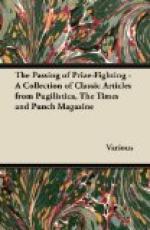appearance, which approaches nearly to that of the
St. Giles’s Group, being changed, on
Sundays, to a variegated-coloured surface, with bright
buttons and a shining “four-and-nine”—goss.
This class includes the upper portion of the Whitechapel
Group, and the two lower strata of the Clapham
Group. The Whitechapel Group is the
most elevated layer of the inferior series. The
Shabby Genteel stratum occupies a wide extent on the
Surrey side of the water—it is part of the
Clapham Group, and is found in large quantities
in the neighbourhood of Kennington, Vauxhall, and
the Old Kent-road. A large vein of it is also
to be met with at Mile-end and Chelsea. It is
the lowest of the secondary formation. This stratum
is characterised by its fossil remains—a
great variety of miscellaneous articles—such
as watches, rings, and silk waistcoats and snuff-boxes
being found firmly imbedded in what are technically
termed avuncular depositories. The deposition
of these matters has been referred by the curious
to various causes; the most general supposition being,
a peremptory demand for rent, or the like, on some
particular occasion, when they were carried either
by the owner, his wife, or daughter, from their original
to their present position, and left amongst an accumulation
of “popped” articles from various districts.
The chief evidence on this point is not derived from
the fossils themselves, but from their duplicates,
which afford the most satisfactory proof of the period
at which they were deposited. Articles which appear
originally to have belonged to the neighbourhood of
Belgrave-square have been frequently found in the
depositories of the district between Bethnal-green
and Spitalfields. By what social deluge they could
have been conveyed to such a distance, is a question
that has long puzzled the ablest geologists.
Immediately above the “shabby genteel”
stratum are found the people who “keep a shop
concern, but no shay;” it is the uppermost layer
of the Metamorphic Class, and, in some instances, may
be detected mingling with the supra-genteel Clapham
Group. The “shop and no shay”
stratum forms a considerable portion of the London
basin. It is characterised by its coarseness
of texture, and a conglomeration of the parts of speech.
Its animal remains usually consist of retired licensed
victuallers and obese tallow-chandlers, who are generally
found in beds of soft formation, separated from superincumbent
layers of Marseilles quilts, by interposing strata
of thick double Witneys.
Having proceeded thus far upwards in the social formation, we shall pause until next week, when we shall commence with the lower portion of the TRANSITION CLASS—the “shop and shay people”—and, as we hope, convince our readers of the immense importance of our subject, and the great advantage of studying the strata of human life
[Illustration: UNDER A GREAT MASTER.]
* * * * *




